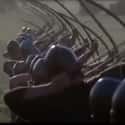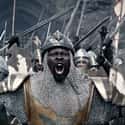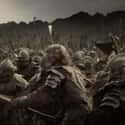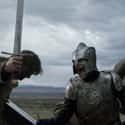-
(#9) Once You Breach The Castle Walls, A Siege Is Over
On paper, castle sieges have all the ingredients for a great battle scene. The invading army faces seemingly impenetrable defenses and has to throw away countless lives to breach them. On the defending side, the stakes couldn't be higher: Turn back the enemy or perish. Most of these siege battle scenes, like the Battle of Helm's Deep in The Two Towers, hinge on whether the attacking enemy can break through the castle walls. Once that happens, it's all over (barring a miraculous rescue by a wizard).
But real siege battles weren't so simple. Most later stone castles in the medieval period were actually the center of a sprawling town that had its own defensive walls. If an attacking army could breach the town's outer walls, the defenders would simply retreat to the castle, which often had even more fortified walls.
Medieval armies had many techniques to go over, around, through, or even under castle walls. But a frontal assault was usually an attacking army's last resort. Instead, attacking medieval armies tried to negotiate with the castle defenders for a peaceful surrender. If that didn't work, the next option was to starve them out.
-
(#12) Arrows Were Like Modern-Day Artillery
Movies and TV shows make longbows out to be even more dangerous than they actually were. During Braveheart's Battle of Falkirk, for example, Longshanks orders his archers to fire on the Scots while they fight with the English, to devastating effect. Longbows act like modern-day artillery pieces, raining down doom from long range, and either softening an army for an infantry assault or destroying it outright. Longbows are essentially medieval super-weapons.
In reality, while longbows were an important component of medieval warfare, they weren't the one decisive factor. Armies did use them to thin out enemy ranks, but they couldn't wipe out an enemy army entirely - and that usually wasn't the goal anyway. More often, longbows were used to harass the enemy to lower their morale, or to contain the enemy's position so it couldn't make a flanking maneuver.
-
(#5) Everyone Used Swords (Aside From Maybe One Special Axe Guy)
Sword fights are inherently cinematic. Onscreen, medieval warfare often boils down to thousands of individual sword fights. Not only does every combatant wield either a sword or a longsword, when the fighting starts, everyone pairs up with an enemy and clangs their swords together until one of them gets the advantage. Win enough one-on-one fights and you win the battle.
The truth is, swords are wildly over-represented in movies and TV shows. In the early Middle Ages (the seventh to ninth centuries), swords were expensive to make and usually only available to the wealthiest fighters. Eventually, sword-making techniques advanced and they became more common, but they were still only one of many weapons available.
Medieval weapons were made for specific purposes. Swords are great for up-close fighting, but spears, pikes, and halberds offer much more reach. Swords can pierce and slash, which is useful against an unarmored or chain-mailed opponent, but ineffective against plate armor. In that case, you'd want a mace, morning star, war hammer, or another bludgeoning weapon. Medieval armies typically used all of the above weapons and more.
-
(#3) Cavalry Charged Straight Into Infantry At Full Speed
The cavalry charge is a movie's bread and butter. A mob of heavily armored knights gallops directly into a wall of spears and pikes, and mayhem ensues. But there are several problems with this notion. First, the speed. The faster the horse gallops, the more force is behind the knight's attack. But all that forward momentum would also send a knight flying into the back of their horse's head when they hit an obstruction.
Second, the tactics. If a group of mounted knights was going to attack infantry, they typically would only attack after the infantry started to flee the battlefield. Riding full-tilt at a motivated and well-fortified infantry, who are probably holding spears and pikes, would have been idiotic.
Instead, knights had many alternate ways to attack. Real cavalry could often start with a frontal charge and then make a turn just before hitting the enemy. They could dismount and engage the enemy on foot. They could use ranged weapons. Or they could try to encircle the enemy and gradually close in on them.
Of course, the biggest issue with this trope is the horses themselves. Even horses bred for war still want to survive, and few can be convinced to gallop directly into a sharp object.
-
(#1) You Can Just Stab Through Armor
If movies and TV shows are all you have to go on, armor in the Middle Ages was next to useless. Onscreen, a skilled medieval warrior can slice through their opponents with a sword, even if those opponents are wearing full plate armor. Watching enough scenes might make you wonder why everyone spent so much time and money building armor if it provides as much protection as cardboard.
To be fair to Hollywood, medieval art does occasionally depict swordsmen stabbing each other through the armor. But this often occurs in training manuals designed to demonstrate sword fighting technique, not literal events.
First, let's be clear about which kind of armor we're talking about. Chain mail from the early medieval period was susceptible to puncturing from sharp weapons, but plate armor, which covers most or all of the body in steel, was specifically designed to offer more protection than chain mail. Swords and longswords could not punch through steel plate armor.
But plate armor didn't make the wearer invulnerable, either. In the later medieval period, knights began carrying long knives called rondel daggers, which they used to stab enemies in the gaps of their armor. And plate armor only protects from piercing damage, not blunt-force trauma. A heavy weapon like a mace, club, or warhammer could still easily smash and incapacitate an armored opponent.
-
(#2) Sword Fighting Was Like A Lethal Form Of Break Dancing
When two characters fight one-on-one with swords (which would be unlikely to happen on a battlefield anyway), it often resembles an elaborately choreographed dance routine. A typical movie sword fighter might use backflips, somersaults, spin moves, and other kinds of fancy footwork. And if they can toss off a few clever quips, even better.
That type of sword fighting is really a form of 19th-century aristocratic dueling. Medieval sword fighting was a lot more brutal. Hundreds of sword fighting training manuals from the Middle Ages have survived to the present. These manuals advise fighters to win at all costs, including many techniques that might be considered unchivalrous. They typically encourage medieval sword fighters to act quickly and aggressively, and to attack an opponent's weak spots in order to immobilize them and finish them off.
In a real battle, doing a spin move would have been particularly dangerous, because it leaves your back exposed to the enemy (unless they're also doing a spin move at the same time).
New Random Displays Display All By Ranking
About This Tool
Our data comes from Ranker, If you want to participate in the ranking of items displayed on this page, please click here.






